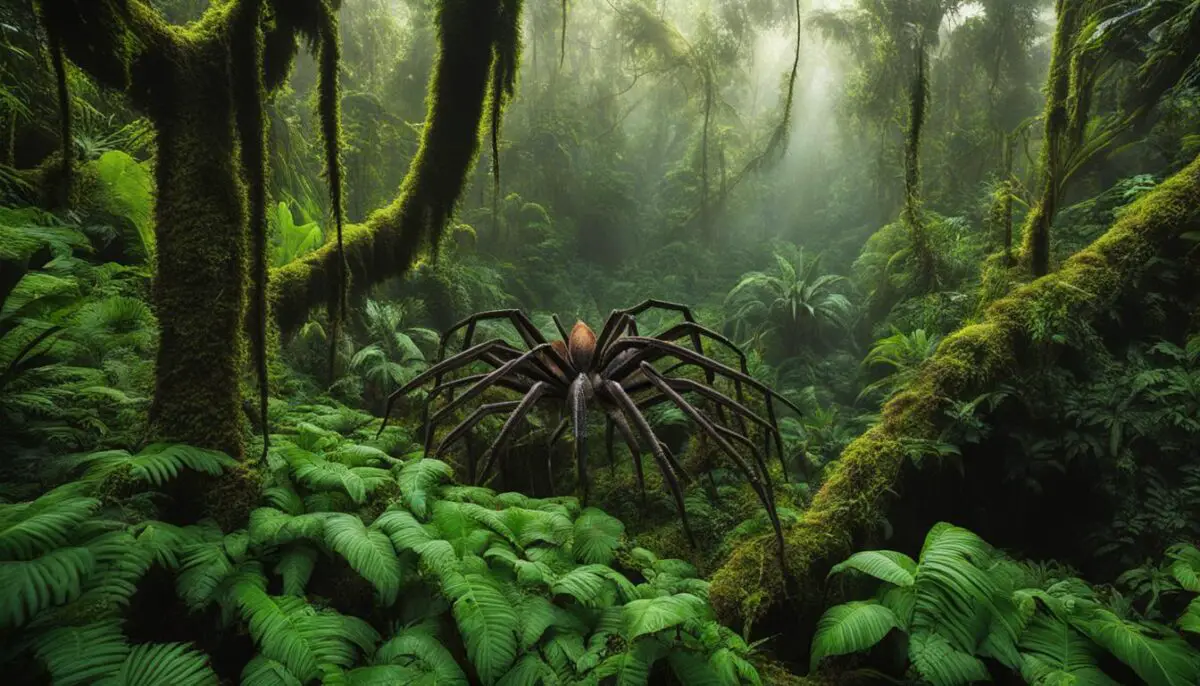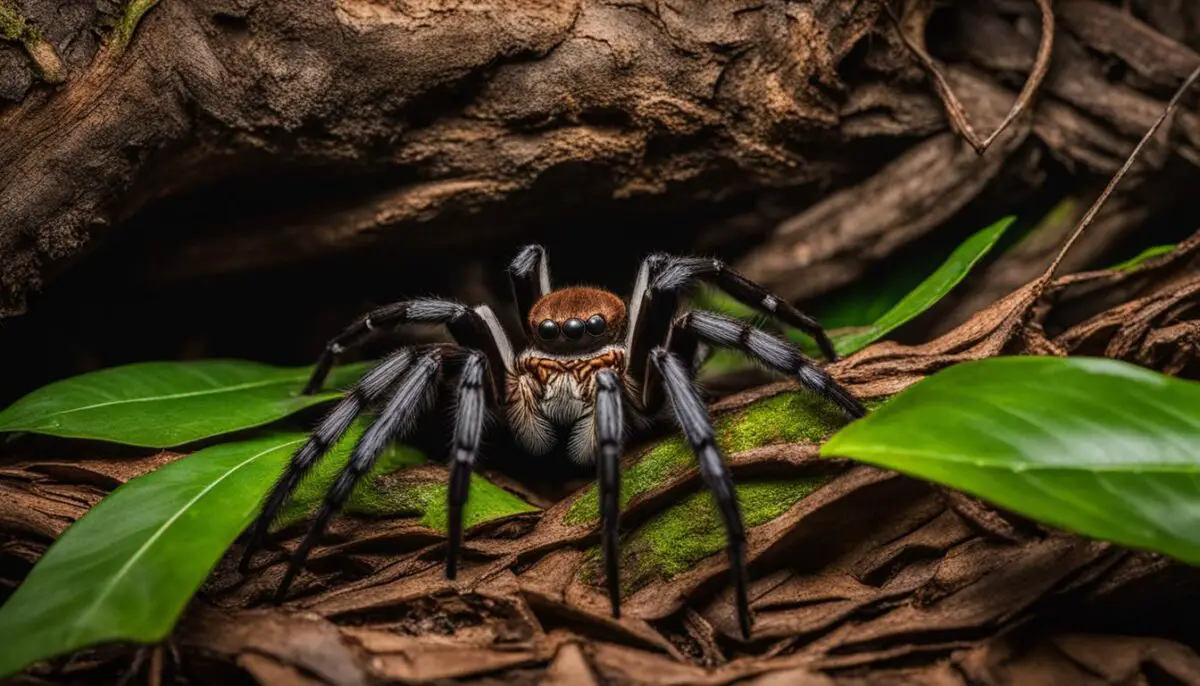The Goliath bird eating spider, scientifically known as Theraphosa blondi, is a remarkable arachnid that resides in the rainforests of South America. As the largest spider on the planet, it captivates both scientists and nature enthusiasts with its impressive size and unique adaptations. Let’s dive into the fascinating habitat of this extraordinary creature.
The Goliath bird eating spider is not called a “bird eating” spider for nothing. With a leg span of up to 12 inches and weighing up to 6 ounces, it has the ability to ambush and consume small birds. However, insects make up the majority of its diet, showcasing its versatility as a predator.
These spiders create burrows under the forest floor, where they reside and line their nests with intricately woven webs. Within this habitat, the Goliath bird eating spider relies on its powerful jaws and venomous bite to capture and consume its prey. Its fangs inject neurotoxins that quickly liquidize the insides of its victims, allowing for easy consumption.
Key Takeaways:
- The Goliath bird eating spider is the largest spider on Earth, with a leg span of up to 12 inches and weighing up to 6 ounces.
- While it is known as a “bird eating” spider, its diet primarily consists of insects, although it has been recorded preying on small birds as well.
- The spider creates burrows under the forest floor and lines its nests with intricate webs for hunting and protection.
- Its powerful jaws and venomous bite equipped with neurotoxins are used to capture and consume prey.
- The Goliath bird eating spider is capable of ambushing and consuming small birds, thanks to its large size and unique adaptations.
Habitat of the Goliath Bird Eating Spider
The Goliath bird eating spider, also known as Theraphosa blondi, is a fascinating creature that calls the tropical rainforests of northern South America its home. This massive spider can be found in countries such as Suriname, Brazil, Guyana, and Venezuela.
Within these rainforests, the Goliath bird eating spider inhabits dense foliage and creates burrows beneath the forest floor. It is adapted to living on the ground rather than in trees, using its burrows as a means of protection and as a hunting ground for capturing and consuming its prey.

The natural habitat of the Goliath bird eating spider is characterized by high humidity, which is essential for its survival. The rainforests provide the perfect environment for these spiders, with a rich diversity of prey species.
These impressive spiders are known for their ability to create intricate webs, which they use to line their nests within their burrows. These webs not only provide structural support but also serve as a trap for unsuspecting prey.
“The Goliath bird eating spider’s habitat is a lush and vibrant world teeming with life. It is within this dense foliage and under the forest floor that these spiders have carved out their niche, showcasing their remarkable adaptability and unique hunting techniques.”
The Goliath bird eating spider’s habitat is essential to its survival, as it provides both protection and a readily available source of food. These spiders have evolved to thrive in this environment, making them remarkable examples of nature’s resilience and ingenuity.
Behavior and Defense Mechanisms
The Goliath bird eating spider, also known as the Goliath spider, exhibits unique behavior and defense mechanisms that allow it to thrive in its native habitat.
Nocturnal Solitary Hunter
The Goliath spider is a nocturnal creature, primarily active at night when it hunts for prey. Its behavior is solitary, preferring to live and hunt alone in its habitat. This adaptation increases its chances of survival by avoiding competition and potential conflicts with other spiders.
Sensitive Leg Hairs
To navigate its environment and detect potential threats, the Goliath spider relies on its sensitive leg hairs. These specialized hairs allow the spider to perceive vibrations, alerting it to the presence of nearby prey or predators.
Urticating Hairs for Defense
When faced with danger, the Goliath spider deploys a unique defense mechanism. It rubs its legs together to release urticating hairs that are tipped with stinging barbs. These tiny hairs can cause irritation and discomfort to potential predators or intruders, serving as a deterrent.
Alongside its urticating hairs, the Goliath spider can also produce a hissing sound by rubbing the bristles on its legs together. This auditory display further intimidates and warns potential threats, offering an additional line of defense.
Quote: Protecting Itself
“The Goliath bird eating spider may not be aggressive towards humans, but when it feels threatened, it has effective ways to protect itself. Its urticating hairs and the ability to produce a hissing sound make it a formidable opponent to anyone who attempts to disturb it.”
Understanding the behavior and defense mechanisms of the Goliath spider reveals the intricate adaptations that enable its survival in the challenging rainforest habitat.

Reproduction and Lifespan
Female Goliath bird eating spiders have a fascinating reproductive process. They produce large egg sacs that can hold between 50 and 150 eggs. These sacs are carefully covered and protected by the spider’s urticating hairs until the spiderlings hatch.
Once the spiderlings emerge from the egg sac, they remain close to their mother until they reach full maturity, which typically takes two to three years. During this time, the mother provides guidance and protection, helping the spiderlings navigate their new environment.
Female Goliath spiders have a significantly longer lifespan compared to males. On average, females can live up to 20 years, while males have a considerably shorter lifespan of about 3 to 6 years.
Conclusion
The Goliath bird eating spider is a magnificent creature that thrives in the lush tropical rainforest habitat of South America. With its enormous size and unique adaptations, it stands as a formidable predator in its natural environment. While its diet mainly consists of insects, the Goliath spider has been observed to capture and consume small birds and other animals as well.
These remarkable spiders create burrows beneath the forest floor, lining them with intricate webs. These structures provide both protection and a convenient hunting ground for the Goliath spider. The tropical rainforests of the region, with their dense foliage and diverse prey species, offer an ideal habitat for these arachnids to thrive.
Understanding the behavior and habitat of the Goliath bird eating spider is crucial to appreciating the fascinating nature of these creatures. From their impressive hunting techniques to their unique defense mechanisms, each aspect of their existence is a testament to the intricate balance of life within the tropical rainforest ecosystem.
In order to preserve the delicate balance of these habitats, we must continue to study and protect the tropical rainforests, ensuring the survival of not only the Goliath bird eating spider but also the countless other species that call these forests home. By appreciating and valuing the intricate web of life in the rainforest, we can help safeguard the future of these remarkable creatures and the ecosystems they inhabit.
FAQ
Where does the Goliath bird eating spider live?
The Goliath bird eating spider, also known as Theraphosa blondi, is native to the tropical rainforests of northern South America, specifically found in countries such as Suriname, Brazil, Guyana, and Venezuela.
What is the habitat of the Goliath bird eating spider?
The Goliath bird eating spider inhabits dense foliage in the rainforests of South America. It creates burrows under the forest floor, where it resides and lines its nests with webs. Its natural habitat is characterized by high humidity and a variety of prey species.
What are the behavior and defense mechanisms of the Goliath bird eating spider?
The Goliath bird eating spider is a nocturnal and solitary creature that primarily hunts at night. It uses its sensitive leg hairs to detect vibrations and warn of impending danger. When threatened, it rubs its legs together to release urticating hairs that are tipped with stinging barbs, causing irritation and discomfort to potential predators or intruders. It can also produce a hissing sound by rubbing the bristles on its legs together.
How does the Goliath bird eating spider reproduce and what is its lifespan?
Female Goliath bird eating spiders produce large egg sacs, which can hold between 50 and 150 eggs. They use their urticating hairs to cover and protect the egg sac until the spiderlings hatch. The spiderlings stay close to their mother until they are fully mature, which can take two to three years. Female Goliath spiders have a longer lifespan compared to males, with an average lifespan of 20 years, while males typically live for only 3 to 6 years.
What is the conclusion about the Goliath bird eating spider and its habitat?
The Goliath bird eating spider thrives in the dense foliage of the rainforests in South America. Its large size and unique adaptations make it a formidable predator in its natural habitat. While it primarily feeds on insects, it has the capability to eat small birds and other small animals. The Goliath spider’s habitat consists of burrows lined with webs, providing them with protection and a suitable environment for hunting.

